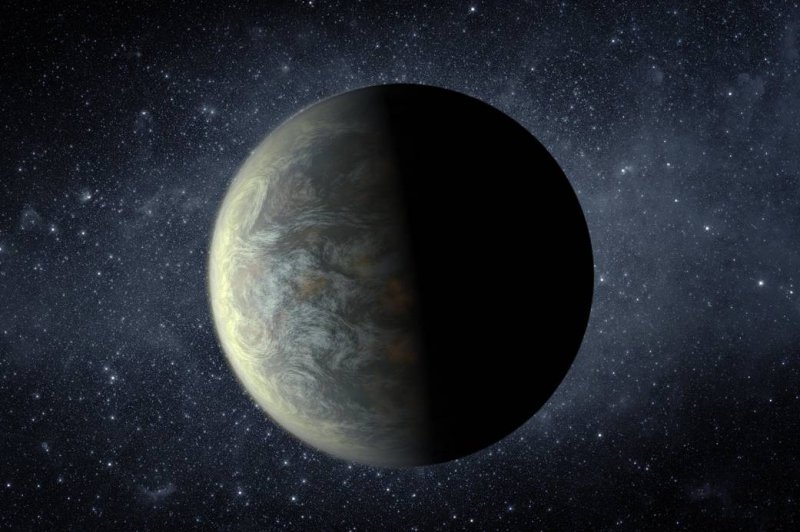NASA's Kepler mission discovered the first Earth-size planets orbiting a sun-like star outside our solar system, Kepler-20e and Kepler-20f. Kepler-20f, illustrated, is the closest sized object to Earth ever discovered, but has a surface temperature of 800 degrees Fahrenheit and is too hot to host life, as we know it.
Illustration by NASA/Ames/JPL-Caltech
Nov. 14 (UPI) -- For the first time, scientists used a 3D climate model that incorporates photochemistry to study the habitability of exoplanets surrounding M dwarf stars.
The findings -- published Thursday in the Astrophysical Journal -- could help planetary scientists know what to look for when surveying potentially habitable exoplanets.
Researchers adopted a 3D climate model, originally developed by scientists at the University of Colorado-Boulder, for the study of Earth's climate, to simulate the atmospheric dynamics of faraway planets -- specifically exoplanets orbiting M dwarf stars.
These stars, also called red dwarfs, give off relatively small amounts light and heat. Originally, scientists thought M dwarfs were rare, and because they're relatively cool, scientists assumed planetary systems surrounding M dwarfs would be unlikely to host life.
More recently, M dwarfs have become the focus of the search for life outside the solar system.
"When we first started looking for exoplanets, we had the idea that sun-like stars are really common," Howard Chen, an astronomer at Northwestern University and the study's first author, told UPI. "But over the last 10 years, we've found that most extrasolar systems have very different characteristics than our solar system."
"The Kepler Survey suggests that M dwarf stars represent between 70 and 80 percent of the Milky Way's stellar populations," Chen said. "In other galaxies, studies suggest red dwarfs could account for between 90 to 100 percent of the stars."
To make the model work for M dwarf stars, Chen and his research partners had to make a few alternations.
"We're able to use different boundary conditions in this particular model to simulate what atmospheres on other exoplanets would be like," Northwestern researcher Daniel Horton, senior author of the study, told UPI.
Unlike the Earth, exoplanets orbiting M dwarf stars tend to rotate very slowly, and most are tidally locked, so only one side of the planet absorbs the bulk of the radiation emitted by the red dwarf.
"This leads to a heterogeneous atmosphere," Horton said.
Previous efforts to simulate the atmospheres of exoplanets using 1D models were unable to account for this feature.
Horton and Chen altered other boundary conditions, too, like the amount of energy and radiation being emitted by the exoplanet's sun.
M dwarfs offer some advantages in terms of habitability. Because they're smaller and dimmer, they live longer.
"Their main sequence, the time frame at which the core burns hydrogen, lasts much longer -- for trillions of years," Chen said. "That's a lot more time and opportunity to develop."
But because they're cooler, their habitable zones -- the region in which an exoplanet could theoretically host liquid water -- are much more intimate. That means potentially habitable exoplanets are more exposed to the ultraviolet radiation put off by M dwarf stars, and M dwarf stars tend to emit higher quantities of UV rays than sun-like stars.
The latest modeling effort confirmed M dwarf stars with elevated UV emissions would be less likely to host life on their surface. In addition to harming lifeforms directly, the models showed excess ultraviolet radiation can vaporize water in an exoplanet's atmosphere, diminishing the exoplanet's chances of sheltering life.
The simulations also highlighted the importance of ozone. For exoplanets surrounding M dwarf planets, the ozone layer is especially important, as it can help shield life from dangerous UV rays.
At the moment, the work of Chen and Horton only can provide a picture of what the atmosphere of a habitable exoplanet orbiting an M dwarf star might look like in theory.
Scientists don't yet have the technology to study the chemical composition and photochemical dynamics of faraway planets.
"Most work on habitability is dependent on future instruments," Chen said. "Unfortunately, Hubble, which is otherwise great, is quite old and can't really quite resolve exoplanet atmospheres."
Scientists hope that Hubble's successor, the James Webb Telescope, will provide the kinds of spectroscopic details needed to characterize the atmospheres of exoplanets in M dwarf systems, and to make determinations about an exoplanet's odds of harboring life.















